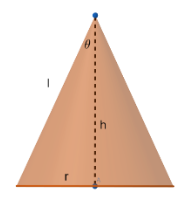Question
Question: Show that semi-vertical angle of right circular cone of given surface area and maximum volume a give...
Show that semi-vertical angle of right circular cone of given surface area and maximum volume a given slant height l is tan−1(221).
Solution
Hint: First find the surface area of the cone. After that, take l=h2+r2 and compare to get the volume. Then for maximum volume, drdV=0, from this you will get the value of S and substitute in l, you will get the value of l in terms of r and also you will get the value of h. The take tan of semi vertical angle and you will get the answer.
Complete step-by-step answer:

Now the surface area of the cone will be S=πr2+πrl where r is the radius and l is the slant height of the cone.
Now l=πrS−πr2……….. (1)
Also from above figure we know that h2+r2=l2, where h is the vertical height of the cone.
So we get, l=h2+r2 ……….(2)
From (1) and (2), we get,
h2+r2=πrS−πr2
Squaring both sides we get,
